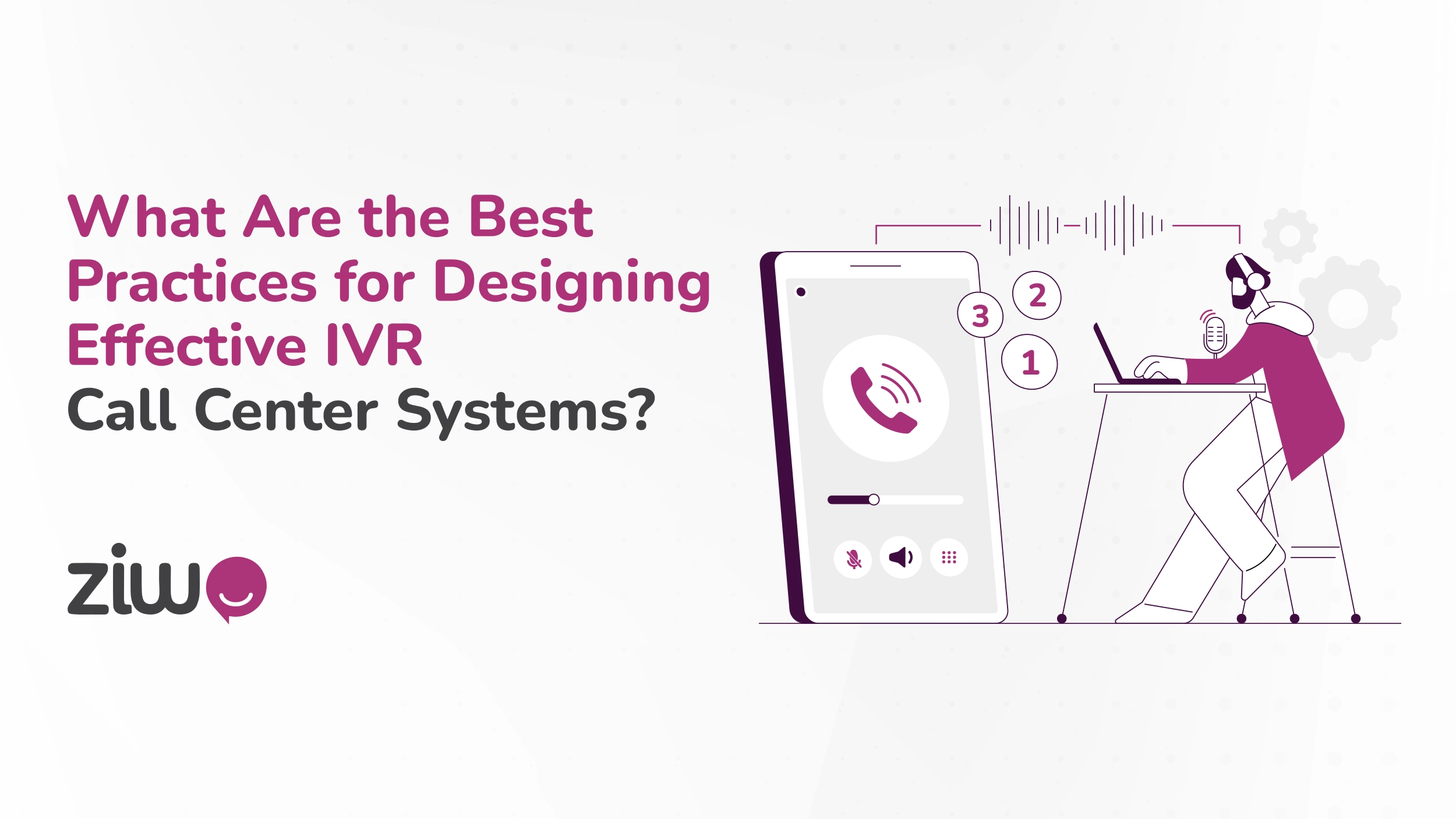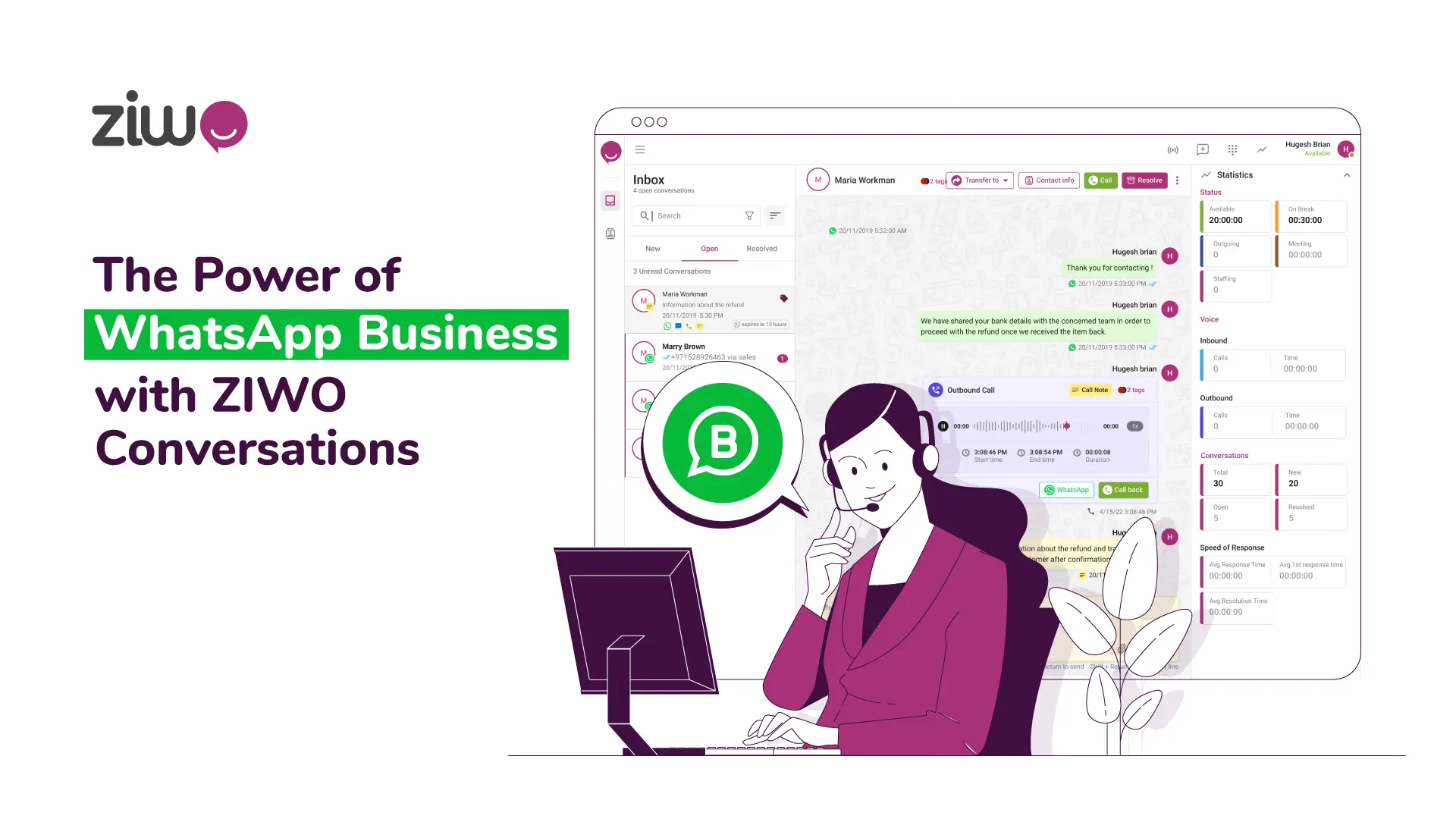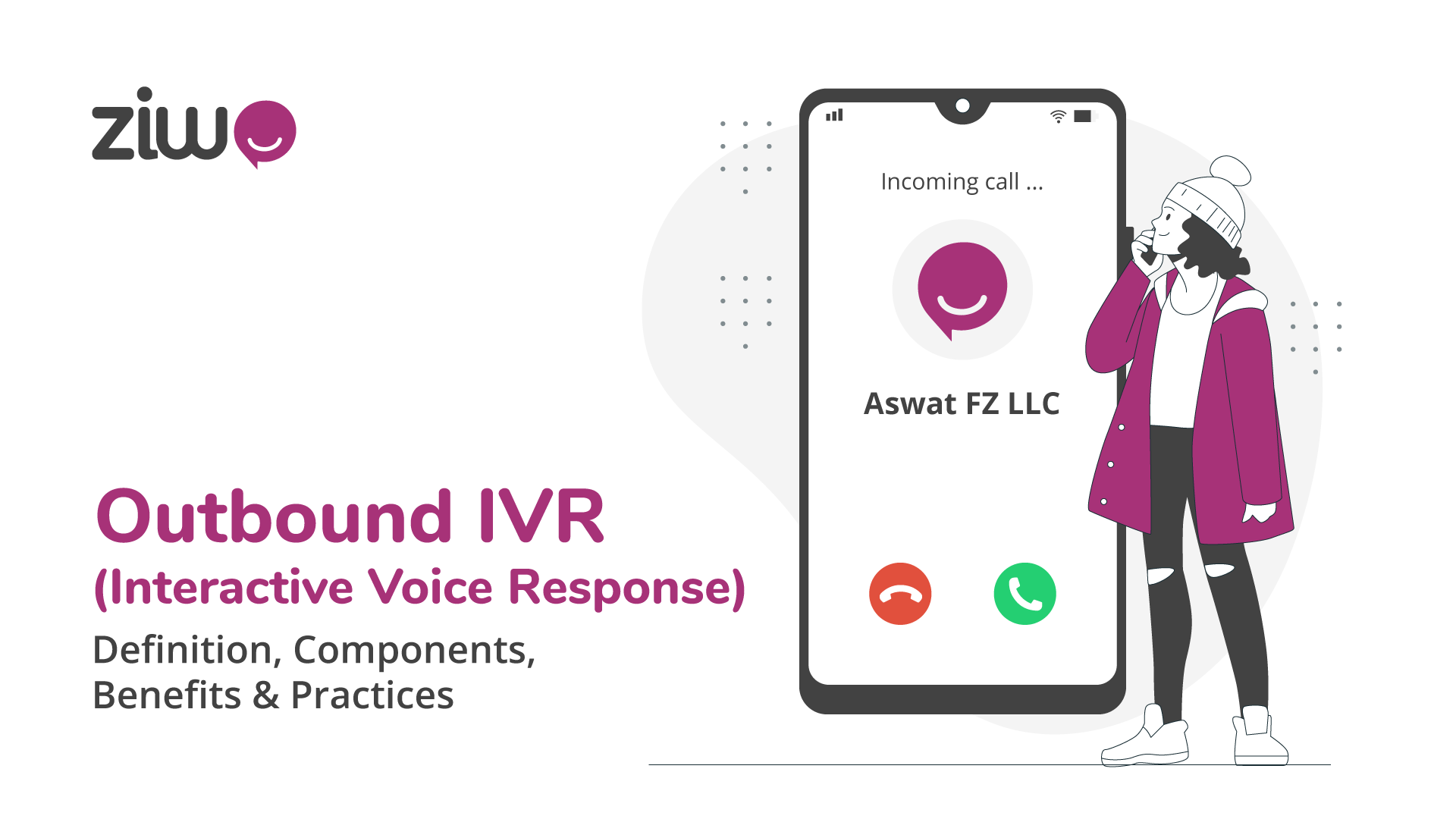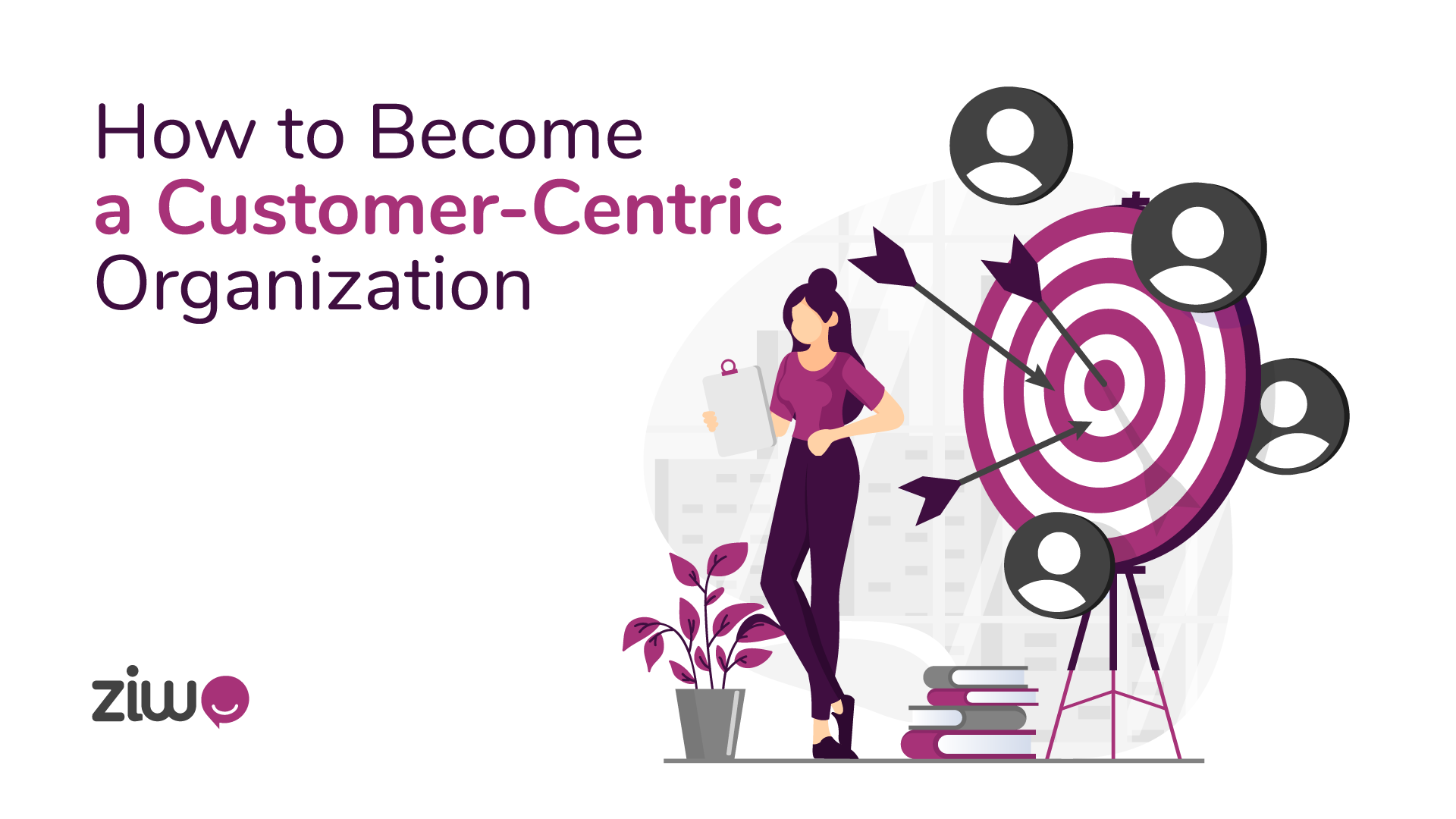
Quelles sont les meilleures pratiques pour concevoir des systèmes de centre d'appels IVR efficaces ?
Vous venez de terminer la mise en place de votre business cloud call center. Tout le travail technique est fait et vous vous interrogez sur l'étape suivante.
Vous devez maintenant commencer à concevoir un système decentre d'appels IVR efficace , mais vous ne savez pas par où commencer.
Le client est-il au cœur du processus ? Ou est-ce l'identité de la marque ? Ou les fonctionnalités de vos services/produits ?
Et si vous receviez un guide complet, étape par étape, pour vous aider à réaliser une conception optimale du système de centre d'appels IVR?
À la fin de cet article, vous aurez acquis des connaissances précieuses grâce à notre expérience dans le secteur du CX et de la gestion des centres d'appels1. Ces connaissances vous permettront de tester et d'optimiser lesperformances du centre d'appels en suivant les meilleures pratiques et en appliquant des stratégies éprouvées.
Introduction à l'importance du système IVR dans les centres d'appels
Un système IVR permet aux entreprises d'économiser du temps et de l'argent en traitant efficacement les volumes d'appels élevés. Il donne la priorité aux appels urgents et les achemine vers les bons agents, tandis que l'IA et la technologie d'apprentissage automatique fournissent les informations demandées3. Cela permet de réduire les temps d'attente et d'améliorer la satisfaction des clients, ce qui se traduit en fin de compte par un centre d'appels commercial plus efficace.
Comprendre les capacités et les limites des systèmes IVR
Un IVR est incroyablement adaptable et capable d'effectuer diverses tâches. Quelle que soit l'opération requise par votre modèle d'entreprise, vous constaterez que l'IVR peut la faciliter. Un système avancé peut prendre en charge les opérations suivantes
- Vérification des nouveaux comptes.
- Acceptation des paiements.
- Assistance au dépannage.
- Mise à jour des informations sur le compte.
- Gestion des demandes de renouvellement.
- Toute autre tâche ne nécessitant pas d'intervention humaine.
La technologie IVR, malgré ses fonctionnalités avancées, présente des limites et des défis basés sur l'expérience de l'opérateur2. Les opérateurs expérimentés s'attaquent à ces limites pour les minimiser. En voici quelques-unes
- Compréhension limitée du langage naturel
- Interactions impersonnelles
- Structures de menu complexes
- Temps d'attente trop longs
Les limitations mentionnées proviennent souvent soit d'une mauvaise utilisation de l'IVR, soit d'un manque de compréhension de votre clientèle et de ses besoins. Cependant, même si c'est la première fois que vous utilisez un IVR, vous avez le pouvoir de le personnaliser pour qu'il serve au mieux vos clients.
Principes clés pour la conception d'un IVR efficace
Devriez-vous vous concentrer sur les moteurs de l'entreprise, tels que les produits, les services et les autres ressources que vous pouvez offrir ? D'autres se concentrent sur le client. Pour nous, une conception efficace d'un IVR dépend des deux. Voici trois règles d'or que vous pouvez appliquer pour créer l'IVR de vos rêves.
1-Fixerune structure transparente et logique: Définir clairement l'objectif de chaque option vous aidera à déterminer ce qui est utile pour le client et ce qui ne l'est pas. Vous obtiendrez ainsi un menu court dont les clients pourront profiter. Pour être pratique, votre liste ne doit pas comporter plus de cinq choix.
2-La personnalisationest reine:la personnalité et les préférences de votre clientèle doivent vous être compréhensibles pour une meilleure personnalisation du système IVR. En donnant la priorité aux options couramment utilisées en haut du menu et en plaçant les options non pertinentes plus bas, vous pouvez rendre votre système plus efficace et plus spécifique aux besoins de votre entreprise.
3-Investirdavantage dans des technologies qui changent la donne: La technologie de reconnaissance des appels est essentielle pour que les entreprises gardent une longueur d'avance sur leurs concurrents4. Elle permet d'aller encore plus loin dans la personnalisation. Elle peut déterminer l'identité de l'appelant, la biométrie vocale pour la sécurité, l'identification automatique du numéro, et d'autres technologies encore. Par exemple, le NLP (Natural Language Processing) permet aux ordinateurs d'interpréter et d'interagir avec la parole humaine. Au lieu d'utiliser un clavier ou une méthode multifréquence à deux tons (DTMF), l'appelant peut exposer son problème verbalement et le système le résoudra.
Simplifier les options de menu pour le confort de l'utilisateur
Le confort des clients est essentiel pour que les entreprises puissent traiter efficacement les demandes, dialoguer avec les clients et résoudre les problèmes. La scénarisation des menus IVR peut aider à atteindre cet objectif en fournissant un service rapide, engageant et approprié.
1- Permettre aux clients d'interagir avec la voix et le clavier
La reconnaissance vocale est une technologie de plus en plus avancée. Mais ce n'est pas la meilleure option pour tous les clients. Certains préféreront appuyer sur le bouton plutôt que de parler du problème. Gardez les deux mécanismes disponibles pour satisfaire les clients de tous les goûts.
2- Proposez toujours l'option "Parler à un opérateur".
Il arrive que le client ne trouve pas ce dont il a besoin dans le menu. Doit-il raccrocher sans que son problème soit résolu ? Bien sûr que non. Parler à un opérateur doit être une option, car cela permet au client de mieux expliquer les choses.
3- Permettre aux clients de revenir au menu principal
Après être entré dans un nouveau sous-menu, le client n'a pas trouvé l'option qu'il cherchait. Doit-il mettre fin à l'appel et recommencer ? Cela lui fera perdre un temps précieux. Il suffit d'ajouter l'option "Retour au menu précédent". Ce sera une option qui lui permettra de revenir au menu parent.
4- Mentionnez l'option de menu avant l'action requise
Pour aider votre client à effectuer la bonne action au bon moment, le message vocal enregistré doit être le suivant : "L'option précède l'action " Par exemple, "Pour les ventes, appuyez sur 1", le client effectuera l'action immédiatement sans se demander s'il veut parler à un agent de vente.
5- Inclure une option de rappel
Pour maintenir la qualité de l'appel et éviter les réactions négatives, pensez à ajouter une option de "rappel" au service. Cela permet aux appelants de mettre fin à l'appel en cours et d'en recevoir un autre au cours de la journée, assurant ainsi un service efficace.
6- Ajoutez les départements de votre entreprise au menu principal
Lors de la conception du menu, vous devez vous demander : " À quels services le client doit-il s'adresser ? " Cela vous aidera à mettre en place un menu qui représente parfaitement votre entreprise et qui répond aux besoins des clients de chaque service.
Personnaliser l'expérience IVR
Les êtres humains apprécient la reconnaissance ; ils aiment que quelqu'un les connaisse et se souvienne de leurs préférences. Dans cette section, nous aborderons les astuces cruciales qui permettent au client de sentir que cette relation commerciale est personnelle et que votre entreprise lui accorde de l'importance. Quelles sont les meilleures pratiques IVR pour la personnalisation dans la conception d'un système de centre d'appels?
1- Personnalisez vos messages d'accueil
Pour améliorer le service à la clientèle, utilisez le nom du client dans le message d'accueil et adaptez la durée de l'appel en fonction de l'heure locale de l'appelant. Par exemple, "Bonjour, Kevin" est plus efficace que "Bonjour, monsieur", et commencez la conversation par "Bonjour" si c'est le matin.
Ces messages ont été enregistrés au préalable, mais ils montrent que chaque détail lié au client est essentiel pour vous.
2- Appliquer des messages contextuels
Les messages contextuels clairs sont des options diffusées simultanément en fonction de l'activité récente du client, comme l'achat d'un appareil électronique au cours des 14 derniers jours, et qui offrent des informations pertinentes.
3- Développer les options de libre-service
L'effet de personnalisation s'étend aux options de libre-service, permettant aux clients de consulter l'historique de leurs commandes et leur état actuel, ainsi que l'état de leurs tickets en fonction de leurs interactions les plus récentes.
Considérations technologiques pour les systèmes IVR
Pour vous inscrire au meilleur service IVR, tenez compte de certaines considérations technologiques qui font la différence entre un bon système IVR et un excellent système.
1-Sécurité: Les systèmes IVR doivent être sécurisés pour protéger les données sensibles telles que les informations sur les comptes bancaires et l'historique des traitements des patients contre toute utilisation abusive, en veillant à ce que les normes de conformité protègent la confidentialité et l'intégrité des clients.
2.Disponibilité:Les systèmes IVR nécessitent un examen attentif de la disponibilité des serveurs, qu'ils soient internes ou externalisés, afin de garantir une expérience transparente avec un minimum de temps d'arrêt.
3-Reprise aprèssinistre:le fournisseur de services IVR doit disposer de plusieurs plans en cas de dysfonctionnement des données, notamment en ce qui concerne les sauvegardes, les centres de données multiples et la capacité de stockage de ces centres.
4. Évolutivité: Votre entreprise a le droit de se développer et le nombre de places dans votre centre d'appels augmentera au fil du temps. Vous avez donc besoin d'un système IVR qui considère l'évolutivité du centre d'appels comme un facteur important.
5-Disponibilité: Votre IVR doit s'aligner sur la conception du système de votre centre d'appels pour l'équipe de rotation qui s'étend tout au long de la journée. Le système IVR doit donc fonctionner 24 heures sur 24 et 7 jours sur 7.
Intégration avec les systèmes de CRM et de base de données
L'intégration de votre système IVR à la gestion des relations avec la clientèle permet d'obtenir de nombreuses fonctionnalités qui accompagnent cette intégration.
1-Synchronisation desdonnées: toute mise à jour que l'agent ajoute au profil du client dans le système CRM se répercute instantanément sur l'IVR. Par exemple, si un client vient d'effectuer un achat, le système CRM enregistrera cette activité, qui se reflétera sur les messages clairs del'IVR .
2- Analyses et rapports: Une intégration CRM peut enregistrer le nombre d'appels que chaque agent reçoit ou effectue quotidiennement. Un CRM peut également détecter quand le problème d'un client a été résolu. Est-ce après un seul appel ? Après deux appels ? Cinq appels ?
3- Automatisation des tâches: Les agents, les chefs d'équipe ou les responsables n'ont pas besoin d'assigner ou de déléguer des tâches. En fonction des résultats des appels, l'intégration entre les systèmes CRM et IVR permet d'automatiser les tâches de routine sans intervention humaine.
Tirer parti de l'IA et de l'apprentissage automatique pour un IVR plus intelligent
L'IA et l'apprentissage automatique renforcent la sécurité en garantissant l'identité de l'appelant et sa disponibilité 24 heures sur 24 et 7 jours sur 7, en apportant des solutions instantanées aux problèmes et en permettant de résoudre les problèmes en temps réel grâce à la biométrie vocale.
Meilleures pratiques IVR pour les menus scriptés
Certaines personnes trouvent difficile de scénariser des menus IVR, mais nous trouvons cela agréable. Voici quelques conseils rapides pour rédiger des scripts de menus IVR réussis qui permettent d'obtenir les résultats souhaités.
1 - Gardez lescript concis: Faites en sorte que le menu principal et chaque sous-menu soient aussi courts que possible, d'une durée de 15 à 30 secondes. Développez des scripts d'appel IVR imbriqués qui garantissent que l'appelant restera en ligne jusqu'à la fin.
2-Annoncerles temps d'attente: vous devez annoncer la durée du temps d'attente dans les scripts des menus IVR. De même, l'ajout de l'option "Rappeler" permet au client de décider s'il veut attendre ou choisir un rappel et mettre fin à l'appel.
3-Faciliter lacommunication avec des agents en chair et en os: vous devez ajouter l'option "Parler à un agent en chair et en os" au menu principal pour que le client puisse la sélectionner en cas de problème urgent.
4-Considérer lesnuances culturelles: Pour répondre aux besoins d'une clientèle diversifiée, créez des scripts dans des langues et avec des accents qui permettent aux clients de se sentir à l'aise et d'interagir. Par exemple, pour les citoyens des États-Unis et du Royaume-Uni, utilisez les deux accents. Pour les régions MENA, l'arabe est dominant, mais l'accent égyptien diffère de l'accent darja, par exemple.
Rédiger des invites claires et concises
Lesmessages-guides clairs sont finalement des contenus qui doivent être transmis à un client particulier. Si le client a l'impression qu'ils n'ont aucun rapport avec lui, il s'en désintéressera certainement. Adoptez donc les règles suivantes :
1-Faites en sorte que le client se sente bien accueilli en utilisant un langage et des expressions amicales qui l'encouragent à répéter l'appel.
2-Les mots ne sont pas le seul facteur influent dans le processus, mais aussi le ton. Enregistrez un ton de voix qui fait baisser la tension dans n'importe quelle situation.
3-Ne laissez pas une caractéristique dominer le script ; équilibrez conversation et information pour que le client puisse poser des questions et trouver des réponses.
Utiliser le langage naturel pour une meilleure expérience utilisateur
Le SVI en langage naturel a révolutionné la technologie en permettant aux clients d'exprimer verbalement leurs problèmes ou leurs demandes, en transformant leur discours en interactions interactives. La reconnaissance automatique de la parole permet également aux IVR de convertir la voix en texte compréhensible, ce qui facilite l'expression des préoccupations des clients sans qu'ils aient à se fier à des numéros de clavier spécifiques.
Test et optimisation des systèmes IVR
L'optimisation des systèmes IVR est sans limite. L'amélioration du système passe donc d'abord par des tests continus. Dans ce cas, plusieurs types de tests sont à mettre en place:
1- Test de charge du SVI: Ce type vous permet de comprendre comment un système IVR interagit sous la charge prévue, en simulant la capacité d'appel attendue.
2- IVR Stress Testing: En utilisant une charge dépassant la capacité de charge attendue, ce test est mis en œuvre pour déterminer la limite supérieure de capacité du SVI et vérifier comment le système SVI se comporte à cette limite.
Mise en œuvre du retour d'information des utilisateurs en vue d'une amélioration continue
À la fin de l'activité d'un client avec n'importe quelle partie de votre entreprise, comme les ventes, la gestion des comptes, le succès des clients, etc., le système IVR peut ajouter une invite claire pour recueillir des commentaires.
Voici quelques indicateurs qui déterminent la satisfaction des clients :
1- Net Promoter Score (NPS)
Le NPS indique comment les clients peuvent devenir des promoteurs de la marque par le biais du bouche-à-oreille, avec des questions supplémentaires pour améliorer la conversation.
- Sur une échelle de 1 à 10, quelle est la probabilité que vous recommandiez [Votre entreprise] à un ami ou à un collègue ?
- Compte tenu de votre (récente) expérience d'achat, quelle est la probabilité que vous recommandiez (nom de l'entreprise/du produit) à un ami ou à un collègue ?
- Quelle est la probabilité que vous recommandiez (nom de l'entreprise/du service) à quelqu'un qui a des problèmes professionnels similaires aux vôtres ?
- Sur la base de votre interaction avec notre équipe d'assistance, quelle est la probabilité que vous recommandiez (nom de l'entreprise/du produit) à votre ami ou collègue ?
- Suite aux dernières mises à jour des fonctionnalités, quelle serait la probabilité que vous recommandiez (nom du logiciel) à un ami ou un collègue ?
2- Score de satisfaction client (CSAT)
La mesure CSAT évalue l'expérience du client, et non les recommandations commerciales. Les consultants estiment qu'elle est directement liée à l'augmentation du chiffre d'affaires de l'entreprise. Des phrases de script IVR peuvent être utilisées à cette fin.
- Dans quelle mesure a-t-il été facile de résoudre votre problème avec [votre entreprise] aujourd'hui ? Très difficile, difficile, ni l'un ni l'autre, facile, très facile.
- Êtes-vous satisfait de la qualité des produits que vous venez de recevoir ?
- Comment s'est déroulée votre expérience d'achat en général ?
- Êtes-vous satisfait de la clarté des informations fournies sur la police d'assurance ?
- Dans quelle mesure avez-vous été satisfait de la facilité d'utilisation de notre application mobile ?
3- Score d'effort du client (CES)
Cette mesure de la satisfaction vérifie l'effort que le client a fourni pour atteindre son objectif avec votre entreprise. Ici, vous pouvez ajouter des invites claires descript IVR sous forme de questions :
- Sur une échelle de 1 à 7, quelle a été la facilité d'utilisation de la fonctionnalité X ?
- A-t-il été facile d'interagir avec notre équipe ?
- A-t-il été facile de trouver les informations que vous souhaitiez sur notre site web ?
- Comment évaluez-vous la facilité de compréhension de la solution fournie par notre représentant ?
- A-t-il été facile de planifier un appel de suivi ou une session d'assistance ?
Tests A/B et optimisation de l'efficacité des menus IVR
Un site web d'E-Commerce a mené un plan de test A/B et d'optimisation de l'IVR après avoir découvert que 50 % des appelants abandonnaient l'appel. Dans un souci d'amélioration continue, l'organisation a remplacé le menu principal par un nouveau menu, en veillant à ce que les options soient plus pertinentes pour les clients. Ce cas démontre l'importance de mener des tests A/B pour une amélioration continue.
L'ancien menu était conçu pour être simple. Le nouveau menu, "A", visait à fluidifier le processus en se concentrant sur la gestion des commandes, la vérification des prix des produits et la résolution des problèmes techniques. Le second menu, "B", se concentre sur la gestion des comptes, les ventes, les finances et le support technique. Les deux scénarios ont donné des résultats plus efficaces que le script original, mais l'un d'entre eux est plus performant. La question demeure : quel menu est le plus efficace ?
Voici quelques étapes qui feront du test A/B le meilleur :
1- Identifiez l'élément à tester. Il peut s'agir de
- Tonalité
- Longueur du menu
- Libellé de l'invite
- des options.
Dans le cas précédent, nous avons choisi les options.
2- Faire une supposition par oui ou par non. Sur la base de cette hypothèse, élaborez un scénario et un autre qui lui est opposé. Si le premier obtient de meilleurs résultats, votre hypothèse est juste ; si le contraire se produit, votre hypothèse est fausse.
Précédemment, nous avons supposé que l'amélioration continue pour de meilleures options réduirait le taux d'abandon.
3- Créez et alignez deux scénarios avec la règle qui vous demande de ne changer qu'une seule variable.
4- Vérifiez que les deux scénarios sont testés et fonctionnent efficacement.
5- Désigner des interlocuteurs aléatoires qui seront exposés aux deux scénarios. Appliquez le scénario "A" à une partie des appelants et le scénario "B" à une autre partie. Il est préférable que le ratio soit de 50/50.
6- Analyser les données et définir les paramètres qui seront utilisés pour prendre la décision.
7- Choisir et mettre en œuvre le scénario le plus performant pour la clientèle ciblée.
Conclusion : L'avenir de l'IVR dans l'amélioration des opérations des centres d'appels
Le domaine des systèmes IVR dans les centres d'appels est encore en pleine évolution. Dans cet article, nous avons discuté de toutes les meilleures pratiques IVR que vous pouvez appliquer et mettre en œuvre dans différents scénarios pour atteindre vos objectifs commerciaux avec l'aide du système IVR.
Références bibliographiques
1 - Avancées technologiques dans les systèmes IVR :
¹ Middleton, C., & Longford, G. (2016). Internet et les télécommunications : The Transformation of Voice Services. MIT Press.
2 - Meilleures pratiques en matière de conception de SVI et d'expérience client :
² Levin, D. (2017). Les systèmes IVR dans les centres d'appels modernes : Automatisation et expérience client. McGraw-Hill.
3 - Intégration de l'IA et de l'apprentissage automatique dans le SVI :
³ Roberts, H., & McKenzie, A. (2020). AI and the Future of Interactive Voice Response Systems in Call Centers (L'IA et l'avenir des systèmes de réponse vocale interactifs dans les centres d'appels). Technology and Innovation Management Review, 13(4), 42-58.
4 - Satisfaction des clients et personnalisation dans les IVR :
⁴ Johnson, K., & Roe, C. (2017). Metrics That Matter : Using CSAT and NPS to Improve Call Center Operations (Utilisation du CSAT et du NPS pour améliorer les opérations des centres d'appels). Journal of Customer Service Strategy, 15(1), 22-34.











